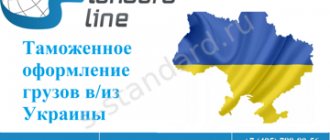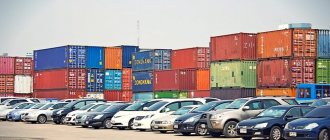Material from Documentation.
Jump to: navigation, search
Export duties on oil in Russia
- one of the main types of export duties in Russia.
Oil export duty rates vary depending on the situation on the world oil market. As of March 1, 2014, the oil export duty was $384 per ton. The preferential duty rate on oil from Eastern Siberia, Caspian fields and the Prirazlomnoye field is $189. The duty on ultra-viscous oil (equal to 10% of the duty on oil) is $38.4.[1]
[edit] History
Main article
:
History of oil export duties in Russia
Oil export duties were introduced in Russia at the beginning of 1992. Initially, its rate was 26 ECU per 1 ton of exported oil, but in June 1992 the rate was increased to 38 ECU per ton.[2]
In November 1993, the duty rate was set at 30 ECU/t. With the liberalization of oil prices in early 1995, the export duty was reduced to 23 ECU/t, and then, from April 1995, to 20 ECU/t. In April 1996, the export duty was reduced to 10 ecu/t, and from July 1, 1996 it was abolished. At the same time, to compensate for the shortfall in tax revenues, oil excise tax rates were increased.[3]
At the beginning of 1999, in order to replenish the revenue side of the state budget, export duties were restored. At the same time, the duty rate was linked to the world price of oil: at the world price of Russian oil from $9.8 to $12.3 per barrel, the duty rate was 2.5 euros per ton, at a price above $12.3 per barrel - 5 euros per ton. [4]
In the context of rising world oil prices, the export duty rate has been increased several times. Thus, in contrast to the situation in the first years of reforms, when the oil export duty rate did not change sometimes for a year or more, since 1999 the export duty rate began to be set taking into account the price of Russian oil on the world (European) market and was revised quite often. At the same time, there were no formalized mechanisms for linking the amount of export duty to the level of world oil prices.[5]
Since 2002, the maximum amount of export customs duties on oil and the mechanism for determining the export duty rate depending on the level of world oil prices have been established by law. Amendments to the Law of the Russian Federation “On Customs Tariffs”, approved by Federal Law No. 126-FZ, were the first to legally establish maximum export customs duties on hydrocarbons, which vary depending on the level of world prices. For oil, the export duty was set at 0% when the average price of Urals oil on world markets over the previous two months was up to $109.5/t (that is, up to $15/barrel); when the world oil price is from 109.5 to 182.5 dollars/t (that is, from 15 to 25 dollars/barrel), the export duty rate should be set in an amount not exceeding 35% of the difference between the actual average oil price for the two previous months and 109.5 dollars; if the world oil price is more than $182.5/t (that is, more than $25/barrel), the export duty rate is set at an amount not exceeding $25.53 and 40% of the difference between the actual average oil price for the two previous months and 182.5 dollars. The introduction of this mechanism provided both the necessary flexibility and predictability of the tax burden.[6]
In 2004, Federal Law No. 33-FZ of May 7, 2004 changed the procedure for calculating the marginal (maximum) rate of oil export duty. Since August 1, 2004, a more progressive scale has been established for calculating the marginal rate of export duty on oil, which is still in effect today.[7]
Thus, the export duty on oil is levied when the world price of Russian oil is more than $15 per barrel. At the same time, with an increase in the world price of oil, the share of tax withdrawals progressively grows (up to 65% of each additional dollar of export revenue when the oil price exceeds $25/barrel).[8]
In accordance with the established procedure, the monitoring period for oil prices on world markets was from 2002 to 2008. appeared every two calendar months (starting from November 1, 2001). The export duty rate was also set for a period of two calendar months. The new oil export duty rate was introduced on the 1st day of the second calendar month following the end of the monitoring period.[9]
Introduction in 2002-2004. a high progressive rate of oil export duty and mineral extraction tax sharply increased the budgetary efficiency of the tax system and led to a radical redistribution of revenues generated in the oil sector in favor of the state. As calculations of the total tax burden on the oil sector show, the share of taxes in the gross income of the oil sector increased from 28.1% in 2000 to 63.1% in 2008. At the same time, the share of taxes in net income, defined as gross income minus capital, operating and transportation costs increased from 54.4% in 2000 to 85.3% in 2008[10]
Since 2014, Russia has been implementing a tax maneuver that involves a gradual increase in the mineral extraction tax on oil while simultaneously reducing export duties on light oil products and crude oil.[11]
Export duty. How much does it cost to export oil from Russia?
What is an export duty?
Export duty is part of the cost of goods exported abroad, transferred from the exporter to the state. In the case of an oil export duty, this is a certain share of the oil export price paid by oil companies to the federal budget. With the help of the export tax, the state takes part of the income of exporters and redirects it to various needs of the country.
For oil companies, the largest and most important is the export duty on crude oil, but oil companies also pay duties on the export of various types of petroleum products, gasoline, and petcoke.
How is export duty calculated?
The export duty on crude oil is levied on the difference between the actual average monthly price of a ton of Urals and the established standard value. Depending on the cost of a ton of oil, there are 4 main options for calculating the export duty:
1) The actual average price of a ton of Urals is below $109.5 - the duty rate is 0%.
2) The actual average price of a ton of Urals is higher than $109.5, but lower than $146 - the duty rate does not exceed 35%.
3) The actual average price of a ton of Urals is higher than $146, but lower than $182.5 - the duty rate does not exceed $12.78 + 45%.
4) The actual average price of a ton of Urals is above $182.5 - the duty rate does not exceed $29.2 + 30%.
The legislation also provides for the possibility of establishing special calculation formulas for oil with special properties or produced in certain areas, but they do not seriously change the overall picture.
In practice in recent years, formula number 4 has been used, since the average cost of a ton of Urals oil has never in recent years fallen below $182.5 per ton (approximately $25 per barrel).
Additionally, starting from 2021, a correction factor equal to 0.833 is included in the calculation formula. The resulting value of the duty rate is multiplied by it. It was introduced as part of a “tax maneuver” with the goal of gradually reducing the export duty to 0 by 2024 and simultaneously increasing the mineral extraction tax. In 2021, this coefficient will be 0.666.
The current form of the formula for 2021 with Urals above $25 per barrel:
Export duty on crude oil = ((Actual average price per ton of Urals - $182.5) * 0.3 + $29.2) * 0.833
The amount of export duties on various petroleum products is set as a percentage of the export duty on crude oil.
The government, through diversification of rates, encourages oil companies to produce certain oil products, mainly goods with a higher degree of processing. The maximum export trade duty rate is set for crude oil and dark petroleum products (fuel oil, petroleum bitumen, waste petroleum products), while for processed products: distillates, benzene, lubricating oils it is only 30%.
The amount of the export duty for the past month is regularly published by the Ministry of Finance of the Russian Federation on the official website on the 15th. For example, from April 15 to May 14, 2021, the export duty on Urals oil was set at $110.4 per ton.
What does export duty mean for oil companies?
Export duties take up a fairly significant portion of oil companies' expenses. For example, at the end of 2021, the amount of export duty paid by Rosneft amounted to 1,061 billion rubles. or almost 13% of the company's revenue. Tatneft's export duty for the same period reached 94 billion rubles. or more than 10% of revenue.
At a market price of $72 per barrel, approximately $15 must be paid as an export tax. From the formula for calculating the export duty, you can see that the rate is affected only by the price of oil, and linearly. This means that when the price of oil is above $25 per barrel, an increase in the price of a barrel of oil by $1 increases the export duty by $0.25. However, there is one important feature that follows from the process of calculating the fee.
Time lag effect
For each subsequent month, the duty rate is set depending on the average price of Urals for the period from the 15th of the previous month to the 14th of the current month. That is, the average oil price from February 15 to March 14 affects the export duty in April, and from March 15 to April 14 - on the duty rate in May. Such a scheme leads to the formation of a “time lag” effect.
Let's look at a specific example. The Russian Ministry of Finance monitors Urals oil prices from January 15 to February 14, based on which on February 15 it announces what level of export duty is set for the period from March 1 to April 1.
This means that if the price of oil begins to rise sharply from February 16, then the effect of rising oil prices will be reflected in the company’s revenue in the first quarter, but the export duty will increase only in April, which will be reflected in the results of the second quarter. This mechanism can either further improve the financial results of companies when oil prices rise, or worsen them when they fall.
In the fourth quarter of 2021, there was a steady decline in oil prices. Since the export duty “lags” relative to market prices, oil companies were forced to pay a large amount of royalties every month.
For example, based on the results of the fourth quarter of 2021, Lukoil estimated the impact of the time lag at -$2.73 for each barrel of exported oil, which approximately corresponds to $11.5 million in lost operating profit. The opposite effect took place already in the first quarter, when oil prices began to recover.
In addition to the time lag effect, the size of the export duty may be influenced by changes in the structure of exports. With an increase in the degree of processing of exported petroleum products, the duty should be reduced, and with an increase in exports of crude oil or goods with a low degree of processing, it should increase. In practice, it is not always profitable for companies to engage in deep oil refining, but without the existing tax mechanism, the oil refining segment could be in a worse position than it is now.
Summary
In the future, the impact of the export duty on the results of oil companies will gradually decrease, which is associated with the “tax maneuver.” Already in 2024, the duty is expected to be zeroed out, and its place will be taken by an increased mineral extraction tax. However, until then, this fee will continue to have a significant impact on the Russian oil and gas industry, especially during periods of increased volatility in commodity prices.
Shipping
Petroleum products are toxic, flammable and explosive. When transporting them, precautions must be taken. Temperature control is mandatory, and containers are regularly checked for leaks. The driver must be prepared in case of a leak. Drivers and forwarders must be accredited to transport such goods and have an ADR permit.
For trouble-free transportation and registration of petroleum products, you need a permit for transportation along a specific route, documents for containers; insurance that will cover damage in the event of an emergency.
Transportation is carried out in accordance with the European ADR/ADR agreement, the Decree of the Government of the Russian Federation and GOST standards. For the transportation of petroleum products, specialized road transport is used primarily; for delivery over long distances, sea and sometimes rail transport are used. The latter is used for the delivery of large consignments. Moreover, in this case, petroleum products are reloaded onto road transport and then delivered to the gas station.
Note! When preparing cargo for export to Europe, it is necessary to check the transport’s compliance with European environmental standards.
Transportation of petroleum products is possible to the CIS countries, Asian and European countries and any other point in the world.
The essence of the formula
In the “60-66” formula, the first figure is the percentage of the difference between the cost of oil and the cut-off price. Now, as already mentioned, it is 65 percent. The Ministry of Energy, the Ministry of Economic Development and other relevant departments decided to lower it to 60 percent, thereby reducing the costs of oil workers for the export of crude oil.
At the same time, it was decided to unify the rates on petroleum products and fix them at 66 percent of the duty on crude oil. This should make the export of dark petroleum products (fuel oil, vacuum gas oils) less profitable and slightly reduce the cost of gasoline exports. This, in turn, will free up the capacity of refineries that are busy producing fuel oil that no one needs, and redirect them, at least partially, to the domestic market. Moreover, the export duty on gasoline (as an exception) will remain at 90 percent of the oil tax. According to Energy Minister Sergei Shmatko, the change in the formula will not affect the construction of new refineries.
According to the Ministry of Finance, from October 1, the export duty on oil will decrease (with relatively stable prices for hydrocarbons during September) by 7.4 percent - to $411.4 per ton. At the same time, you will have to pay $271.5 per ton for the export of petroleum products, and $370.2 for gasoline.
Oil companies perceived the officials' initiative differently. Thus, Tatneft announced back in June that they would ask officials for 31 billion rubles in lost income. At the same time, the Ministry of Finance estimated the total losses of Bashneft and Tatneft at 8-9 billion rubles annually.
Other oil workers, on the contrary, were happy. Thus, Lukoil, the largest private oil company in Russia, said that it would receive $460-500 million from the government’s new measures at a price of $95 per barrel of oil. “At the same time, I hope that the government’s decision will be implemented and a lower excise tax will be introduced on high-octane gasoline - high-quality, environmentally friendly gasoline - and an increased excise tax on low-octane gasoline,” said RIA Novosti, Lukoil Vice President Leonid Fedun at the end. August.
TNK-BP and Rosneft also found advantages in the reform. According to TNK-BP Holding CFO Jonathan Muir, the government's decision will have an impact on both the Russian-British company itself and the industry as a whole.
Prime Minister's word
In the summer, the industry reform was approved by both relevant departments and Prime Minister Vladimir Putin. However, as the Vedomosti newspaper wrote on September 15, in fact, another change awaits oil workers. According to the publication’s sources, the government decided to transfer the management of the industry to Putin’s favorite “manual control” mode and turn the formula “60-66” into the formula 60 (65) - 60.
The essence of the innovation is that every month the prime minister himself will announce whether the base oil rate is reduced to 60 percent or remains at 65 percent. The government will make decisions based on the results of the work of oil workers - if they increase gasoline prices within the country, the rate will remain high.
The “manual control” mode has not yet been officially confirmed, however, apparently, the innovations will become known very soon: new duties on oil exports should be in effect from October 1.
Calculation of export duties: innovations in 2015
The “tax maneuver” to increase the mineral extraction tax and reduce export duties began to be implemented from the beginning of this year. The new formula for calculating oil duties, taking into account preferential rates, contributed to the fact that for some oil production regions these payments were completely zeroed out.
In general, across the country in February of this year. the tax burden on oil exports decreased 1.5 times from $170.2 (in January) to $112.9 per ton. Over the past two months, tax amounts for other petroleum products (per ton) have also changed:
- high-viscosity oil – $14.2 (decrease by 35.4%)
- dark – $85.8 (33.6% decrease)
- commercial gasoline – $88 (decrease by 33.3%)
- propylene trimers and tetramers – $7.3 (33.6% decrease)
light petroleum products $54.1 (decrease by 33.7%)
Payments to the treasury for liquefied gas have been reset to zero, since according to the formula for calculating the export duty, when the cost of LPG is below $490 per ton, payments are reduced to zero. In January, payments were $48.2.
Certification
Certification of petroleum products and oils is mandatory, since these products are classified as explosive. Product compliance with technical regulations TR CU 030/2012 “On requirements for lubricants, oils and special liquids” is checked. Certification is carried out by specialized certification centers. In addition, a certificate of compliance with the EURO 5 standard is issued.
In addition to mandatory certification, there is voluntary certification, which applies to motor gasoline, diesel fuel and motor and compressor oils. A declaration of conformity is issued for a period of 1 to 5 years or per batch.
Mineral extraction tax and export duties
With a decrease in export payments, as already noted, the burden on subsoil users has increased. Their taxation is regulated by Article 334 of the Tax Code of the Russian Federation, and payments are made for each deposit in use. The object of taxation is oil in stabilized, desalted or defatted form, and the basic indicator is the quantity or cost of oil produced. This calculation is chosen by the taxpayer once and does not change as long as the field is in use.
In Article 342 of the Tax Code, the mineral extraction tax rates for 2015 are set at 530 rubles. (2014 – 493 rubles), and in 2021 the expected level is 559 rubles. However, after a reduction in export duties from January 2015, the rate for “black gold” was increased to 766 rubles. per ton. Other payment amounts have also been adjusted, in particular for gas condensate.
The base rate is adjusted by “floating” coefficients: Kc – the cost of oil on world markets; Kdv – degree of depletion of the deposit; Кз – degree of its reserves; CD – difficulty of oil production (from 0 to 1). This formula changes only if additional calculations are necessary, based on the characteristics of oil production by a particular company.
As for the calculation of customs export duties, a methodology has been created for crude oil and some petroleum products, approved by the Decree of the Russian Government.
In particular, the formula Stneft = 0 is applied if the average price for “black gold” on world markets is not higher than $109.5 or Stneft = 0.35 x (Tsneft – 109.5), if the price is above 109.6, etc. d. Those. in the future, coefficients of 0.45, 0.6 are applied depending on the gradation of oil prices. Cneft means the average price for the monitoring period of crude oil prices in two markets - the Mediterranean and Rotterdam. The duty on other types of oil and hydrocarbons is calculated in a similar way (in this case, using coefficients K1, K2, K3, K4 - with values from 0 to 0.7).
Tweet
See also: Gazprom shares Price of AvtoVAZ shares today Stock quotes
Customs clearance procedure
Customs clearance of petroleum products and oils is carried out at specially equipped checkpoints. The customs clearance procedure includes:
- Declaration. Involves submitting information to complete a declaration in written or electronic form. The last option is only possible for legal entities. You can submit data in person or through a representative.
- Determination of classification code. The cargo is classified according to the HS system and assigned a code. This code is used to determine the rate of customs duty and VAT.
- Customs value control. Since the customs value is determined by the declarant and it is from this amount that taxes and duties are calculated, customs often detects a deliberate underestimation of it. Customs officers are guided by the entry cost. This is the lower threshold below which the cost of the product cannot be. If you really managed to purchase the product at a low price, you need to prepare as many documents as possible confirming this fact. If the declarant cannot prove the value of the goods, then a fine will be imposed on him or the cargo will be confiscated.
- Verification of the fact of payment of mandatory payments. It is recommended to pay taxes and duties and fees in advance, given that it may take some time for funds to be credited. Until the money is transferred to the account, the cargo will not be released. In addition, you must present receipts.
- Inspection and release of goods. Inspection (a thorough examination of the cargo and vehicle) is carried out if the cargo is suspicious, the necessary documents are missing, or any other violations are detected. In some cases, they get by with a customs inspection - a more cursory analysis. If everything is in order, the cargo is released from customs.
If we talk about the Russian Federation, the procedure for customs clearance of petroleum products is carried out no less often than customs clearance, since petroleum products are the main export product. The customs clearance process in this case is also complicated. The goods are not subject to excise tax.
The following operations are carried out within the framework of customs clearance:
- Tank inspection. Its essence is to check the compliance of containers and tanks with standards. Leaks are eliminated. They can lead to an environmental disaster and fire. Compliance with safety standards and compliance with environmental transport standards is checked.
- Inspection of petroleum products. The contents of the tanks are checked by portable analyzers, and their volume is determined.
- Documents are studied: checks, contracts, technical documentation, etc.
- After customs clearance and control of petroleum products, a decision is made on release.









